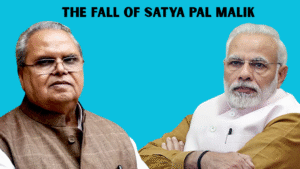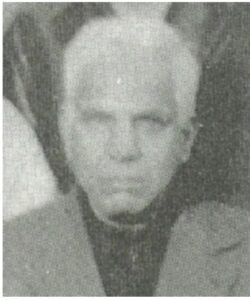In the dark days of 1990, as terrorism gripped the Kashmir Valley, a sinister pattern emerged. Those working in telecommunications, radio, and television found themselves in the crosshairs of radical militants. The twisted logic of these extremists painted innocent civilians as spies, leading to a reign of terror that would forever scar the region. Among the victims of this senseless violence was Bal Krishen Ganjoo (B K Ganjoo), a telecom engineer, whose tragic fate serves as a stark reminder of the brutality inflicted upon Kashmiri Pandits.

Early Life and Education:
B.K. Ganjoo was born and raised in Kanikadal, Chota Bazar, Srinagar. This area, known for its tight-knit community and rich cultural heritage and later for terrorist activities, played a significant role in shaping Ganjoo’s early years. Growing up in the heart of Srinagar, he was immersed in the unique blend of Kashmiri culture that characterized the region before the onset of militancy.
Ganjoo’s academic journey led him to the prestigious Regional Engineering College (REC) in Srinagar, now known as the National Institute of Technology (NIT), Srinagar. This institution, renowned for producing some of the finest engineers in the region, provided Ganjoo with the educational foundation that would shape his professional life.
Professional Life of B K Ganjoo
After completing his education, B.K. Ganjoo secured a position in the Telecommunication Department. This achievement was a source of pride not only for Ganjoo but also for his family and community. Working in telecommunications during this era was considered a significant contribution to the region’s development and connectivity.
Ganjoo’s role in the Telecommunication Department placed him at the forefront of technological advancement in Kashmir. However, it was this very position that would later make him a target in the eyes of extremists who viewed such government employees with unwarranted suspicion.
The Fatal Day: March 22, 1990: An Unsuspecting Return Home
On that fateful day, Ganjoo was returning home during a brief relaxation of the curfew imposed in Srinagar. As a telecom engineer, he had no reason to suspect that he was being targeted. The normalcy of his routine belied the danger that lurked in the shadows, a tragic illustration of how terrorism can shatter even the most ordinary moments of daily life.
A Wife’s Desperate Attempt of Vijay Ji to save her husband
As Ganjoo approached his house, his wife Vijay noticed suspicious men following him. In a moment of quick thinking and desperation, she rushed to bolt the door as soon as he entered. This act of love and protection, however, would prove futile against the determination of the terrorists.
Realizing the imminent danger, Ganjoo ran to the third floor of his house in a frantic attempt to hide. In a last-ditch effort to save himself, he concealed himself inside a large rice bin. The terrorists, meanwhile, ransacked the house, searching every corner for their target.
After an extensive search, the terrorists were unable to find Ganjoo. For a brief moment, it seemed that he might survive this ordeal. This glimmer of hope, however, was quickly extinguished by an act of betrayal that would seal Ganjoo’s fate.
In a shocking turn of events, a Muslim neighbour who had witnessed Ganjoo hiding in the rice drum signalled to the terrorists as they were leaving. This act of betrayal, callous given that Ganjoo had reportedly helped this very neighbour with food supplies just days before, highlights the breakdown of community bonds in the face of extremism.
Armed with this information, the terrorists returned to the third floor. Without hesitation, they fired multiple rounds into the rice bin where Ganjoo was hiding. The telecom engineer, who had dedicated his life to serving his community, died a painful death, bleeding out among the grains of rice that had briefly been his refuge.
It’s important to note that there are conflicting accounts regarding the role of the neighbour in Ganjoo’s murder. Some media reports have suggested that the neighbour did not communicate Ganjoo’s location to the terrorists, as they were also victims of the terrorist violence. At this point, I cannot definitively confirm or deny the neighbours’ involvement in the tragedy. Only Vijay Ganjoo Ji would be in a position to provide a firsthand account of the events that transpired on that fateful day.
However, regardless of the disputed details surrounding the neighbour’s actions, the undeniable and tragic fact remains that B.K. Ganjoo was brutally murdered by radical terrorists. This act of violence, committed against an innocent civilian, stands as a stark reminder of the horrors inflicted upon the Kashmiri Pandit community during this tumultuous period.
The Aftermath: Cruelty Beyond Death
According to certain reports, Ganjoo’s wife, Vijay, was forced to witness the brutal murder of her husband. When she begged the terrorists to kill her too, they cruelly responded that they were sparing her so she could mourn over her husband’s corpse. This psychological torture compounded the trauma of losing her loved one.
Some accounts allege that the terrorists forced Ganjoo’s wife to eat the blood-soaked rice, taunting her that her family should also partake in this “tasty meal.” While the exact details of this act remain disputed, the very allegation speaks to the depths of inhumanity that terrorism can reach, which is indisputable.
Pattern of Violence
Ganjoo’s murder was part of a larger pattern of violence against Kashmiri Pandits and professionals working in media and telecommunications. Terrorists, in their paranoid worldview, often labelled these individuals as “informers” or spies for the Indian government, making them targets for execution.
The murder of B.K. Ganjoo and similar incidents contributed to the mass exodus of Kashmiri Pandits from the valley. Thousands of families were uprooted, leaving behind their homes, livelihoods, and centuries-old cultural heritage. This displacement has had long-lasting consequences on the demographic and cultural landscape of Kashmir.
Remembering B.K. Ganjoo: The B.K. Ganjoo Memorial Park
To honour his memory, a memorial park in Central Delhi was named after B.K. Ganjoo. This memorial serves as a physical reminder of his sacrifice and the larger tragedy that befell the Kashmiri Pandit community. It stands as a place of reflection and remembrance for all victims of terrorism.
In the years since Ganjoo’s murder, there have been ongoing efforts to document these atrocities and seek justice for the victims. However, the path to accountability has been long and fraught with challenges. The importance of keeping these stories alive cannot be overstated, as they serve as a crucial reminder of the need for justice and reconciliation.
Lessons and Reflections
B.K. Ganjoo’s story is a powerful reminder of the individual tragedies that lie behind the statistics of terrorism. Each life lost represents a family shattered, dreams unfulfilled, and communities torn apart. Understanding these personal stories is crucial to comprehending the true impact of extremism.
The labelling of professionals as “informers” based solely on their occupation reveals the dangerous power of misinformation and stereotyping. Combating these narratives is essential to preventing future tragedies and building a more tolerant society.




